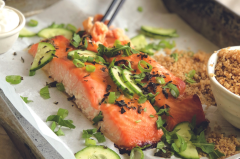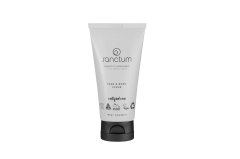Treat your guests to more than just a delicious meal.
Why don’t you prepare a delicious feast for your family and friends with wholesome ingredients that will support their gut microbiome and overall health? By including a variety of foods that contain probiotics, prebiotics and specific gut-loving phytochemicals, your guests’ tummies will leave happy having been served up just what their gut microbiome needs to flourish for better health and wellbeing.
Garlic
Adding a good dose of garlic to dips, sauces and savoury dishes will not only add plenty of flavour but it will also give them a boost in prebiotic goodness. Garlic is rich in fructan, a type of soluble fibre that acts as a prebiotic in the gut. Prebiotics are extremely important as they provide food for our beneficial gut microbiota or bacteria, so that they can grow and survive in the gut.
Garlic contains an active compound called allicin, which gives garlic its immune-boosting properties. Garlic acts like a natural antibiotic, killing off pathogenic bacteria while at the same time promoting the growth of our beneficial microbiota. Eating garlic regularly is a great way to help keep disease-causing bacteria at bay.
Garlic should be prepared and cooked in a certain way to retain its many health benefits. Allicin is activated when you cut or crush garlic. Heat destroys some of garlic’s allicin content, so eating garlic raw when you can is ideal. You can add it raw to salad dressings, dips, pesto and bruschetta, or add it nearer to the end of cooking when possible.
Legumes
Legumes including lentils, chickpeas, kidney beans and black beans are naturally rich in galacto-oligosaccharides. These are a type of soluble prebiotic fibre that is fermented in the large intestine by our gut bacteria. The by-product of this fermentation process is the production of valuable short chain fatty acids (SCFAs), namely butyrate, which play an important role in protecting our gut health. SCFAs encourage the growth of our beneficial microbiota, and they reduce inflammation and help maintain the integrity of the gut lining.
Legumes are a protein staple in many vegan and vegetarian dishes such as curries, nachos, salads, hummus, falafels, veggie patties and dals. Legumes and legume flours can also be used in grain-free sweet treats like cakes, brownies and cookies.
Globe artichoke
Globe artichokes make a tasty starter served with dips, or as a healthy addition to meze plates. Globe artichokes benefit the gut microbiome as they contain
a type of soluble fibre called inulin, which has prebiotic effects. Consuming inulin-rich foods like globe artichoke has been found to increase bifidobacterial and lactobacillus species in the gut. Adding more inulin into the diet can also help increase the production of SCFAs, which helps promote healthy microbiome and intestinal barrier function.
Globe artichokes can also help improve digestion and enhance liver function. Globe artichokes contain cynarin, a phytochemical found mostly in the leaves, which stimulates the production of bile and strengthens liver and gallbladder function to aid digestion.
Globe artichokes can be boiled, steamed, baked and marinated. They’re delicious added to pasta dishes, pizza and salads, as well as stuffed and baked. The steamed leaves are tasty dipped in hummus, baba ghanoush or tzatziki.
Miso
Miso is a traditional Japanese food made from fermented soybeans. This functional food is typically made by fermenting soybeans with salt and a type of fungus called koji or Aspergillus oryzae, along with a grain such as rice, wheat or barley.
Including fermented foods like miso in the diet is a great way to boost your gut health and support healthy digestion. Fermented foods are considered probiotic-rich foods as they contain live bacteria that help increase beneficial microbiota in the gut. It’s important that we have a good balance of these beneficial gut microbiota for a strong functioning immune system, and for the healthy production of our “feel good” neurotransmitters serotonin and dopamine.
The koji mould in miso has been found to help reduce the risk of inflammatory bowel disease.
Another reason miso can benefit our gut microbiome is by providing prebiotic fibres. Soybeans are rich in prebiotic fibres called oligosaccharides that help support our health by stimulating the growth of beneficial microbiota in the gut.
Look for an unpasteurised organic miso and be careful when cooking as these probiotics are killed off by prolonged cooking at high temperatures. Try to add your miso paste to dishes just before you take them off the heat to preserve its probiotic goodness.
Miso comes in a diverse range of colours and flavours, ranging from creamy white miso with a milder sweet taste, red and brown miso which has a richer flavour, and mild and earthy yellow miso. Miso is commonly used in miso soup but it can be used to give extra flavour and health benefits to a variety of dishes including sauces, salad dressings, marinades and glazes for fish, chicken and meat. Try adding some miso to your next pesto. Miso adds a lovely umami flavour to dishes such as stir-fries and noodle dishes.
Oats
Oats are really versatile and can be used in healthy cakes, fruit crumbles, slices and cookies for a healthy gut-loving dessert or after-dinner treat.
Oats are a great source of resistant starch. This is a type of fermentable prebiotic fibre that provides fuel for the good bacteria in the gut and ensures the health and integrity of the gut lining. For optimal gut health you should be aiming to include a variety of fibre-rich sources in your daily diet including resistant starch found in whole oats.
Seaweed
Seaweed is an excellent source of prebiotic fibre that helps enhance the population of beneficial bacteria and supports normal gut and immune function. Seaweed is rich in polysaccharides and polyphenols, which are prebiotic compounds that benefit the immune system and have been found to enhance the production of SCFAs, which nourish the cells in the gut.
There are many different types of seaweed including kelp, kombu, wakame, nori and dulse. Seaweed is a popular ingredient in Asian dishes, particularly Japanese cuisine. Seaweed adds a rich, salty umami taste to savoury meals like soups, stir-fries, salads and fermented veggies. Seaweed flakes can be used on oven-baked chips or to season meats, chicken and fish.
Apples
Apples make a delicious addition to salads, cheese platters, fruit crumbles, pies and cakes. Apples are an excellent source of pectin, which is a type




